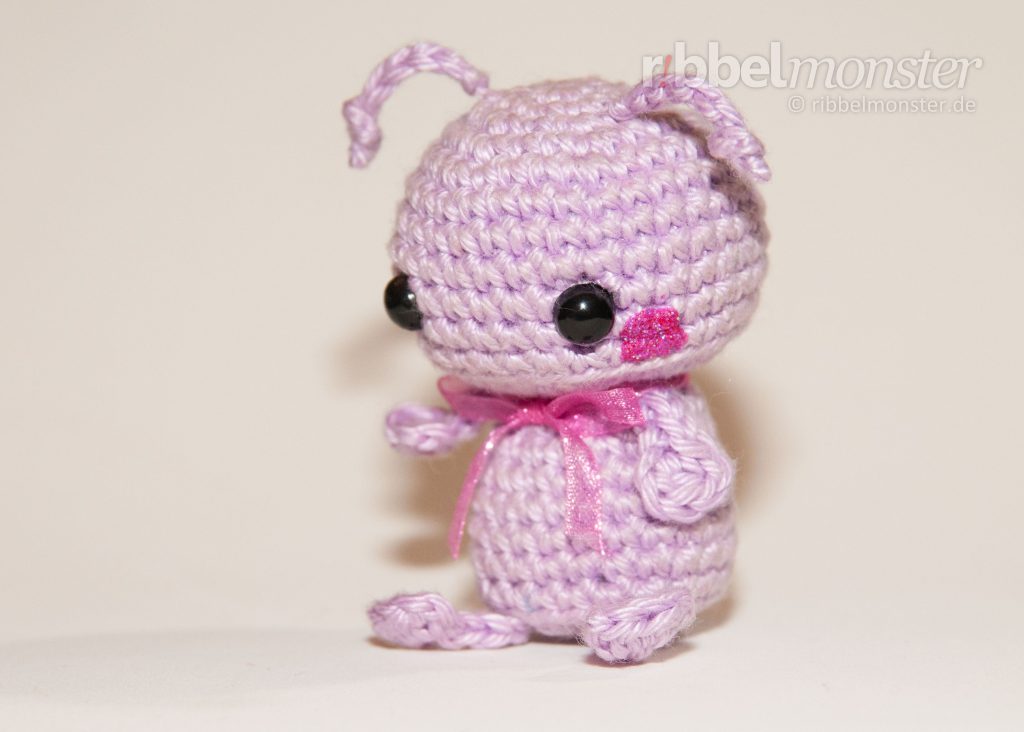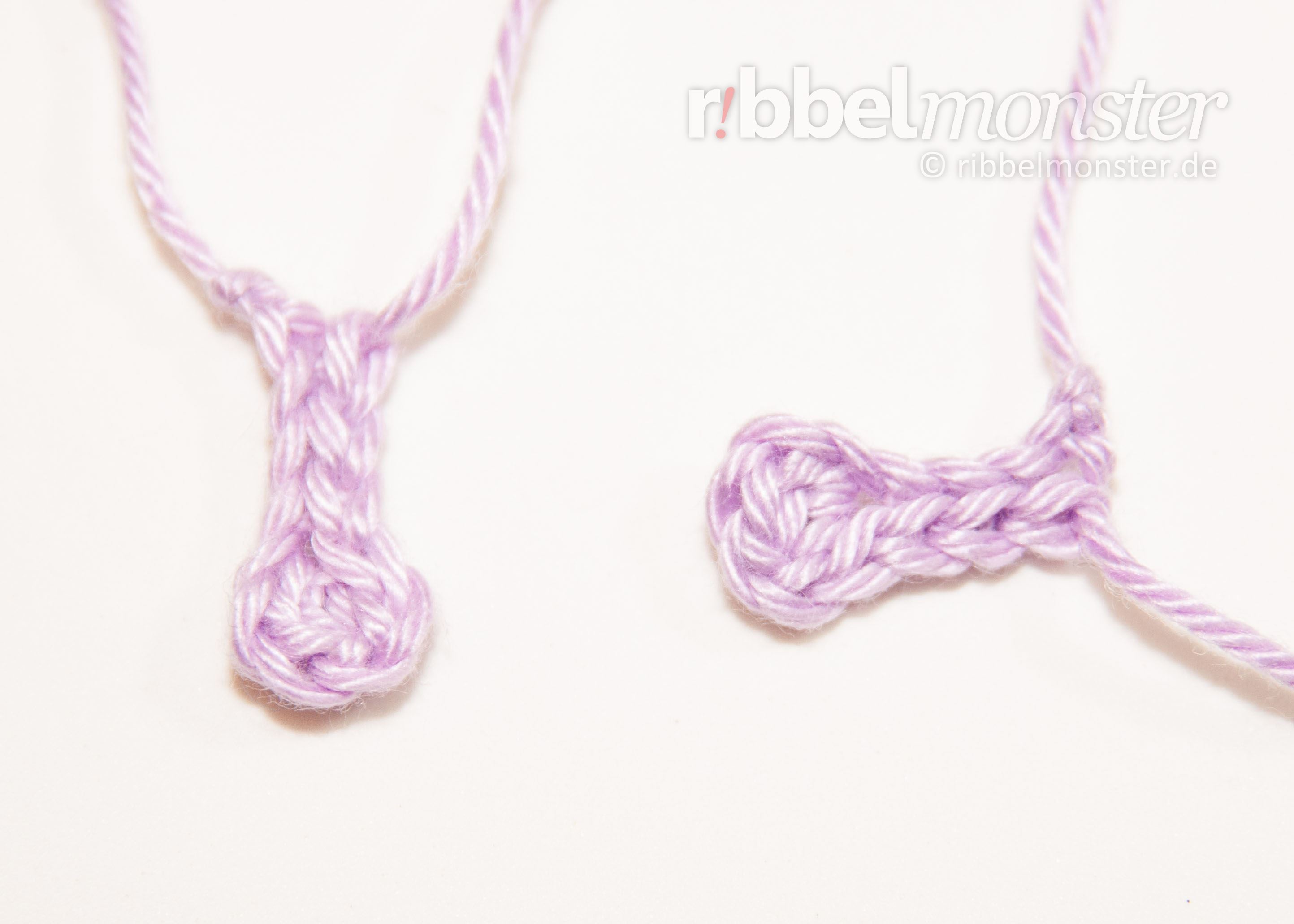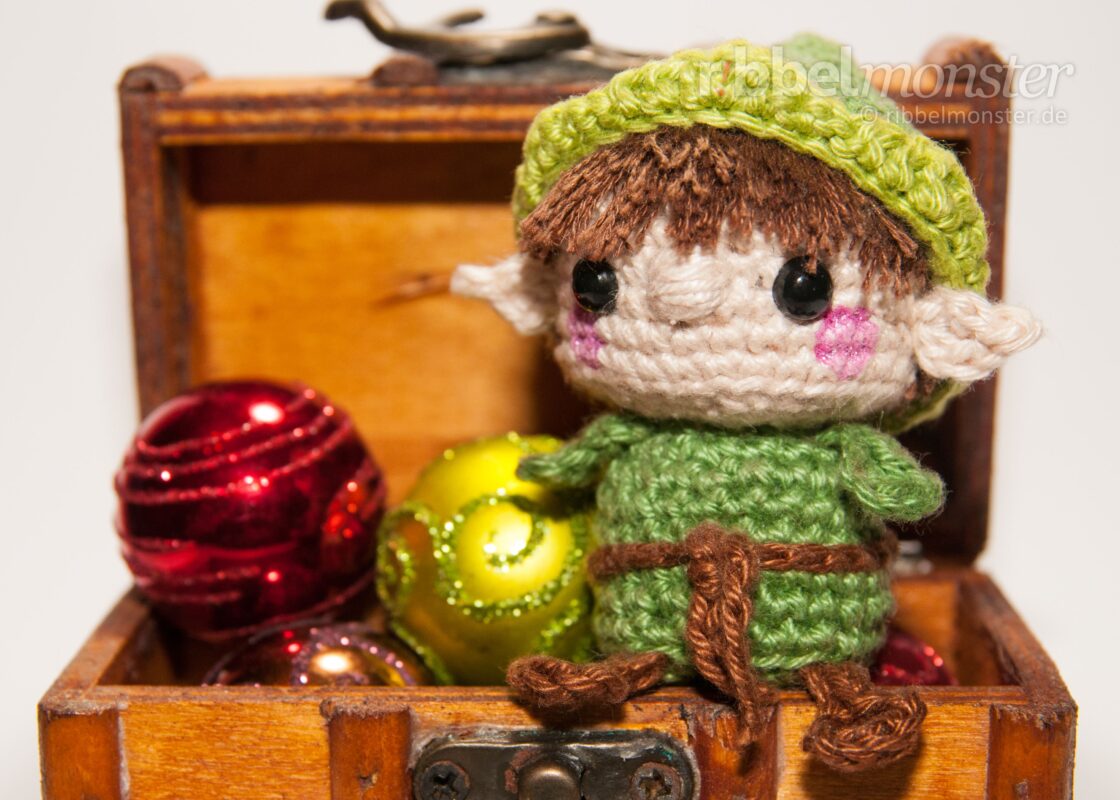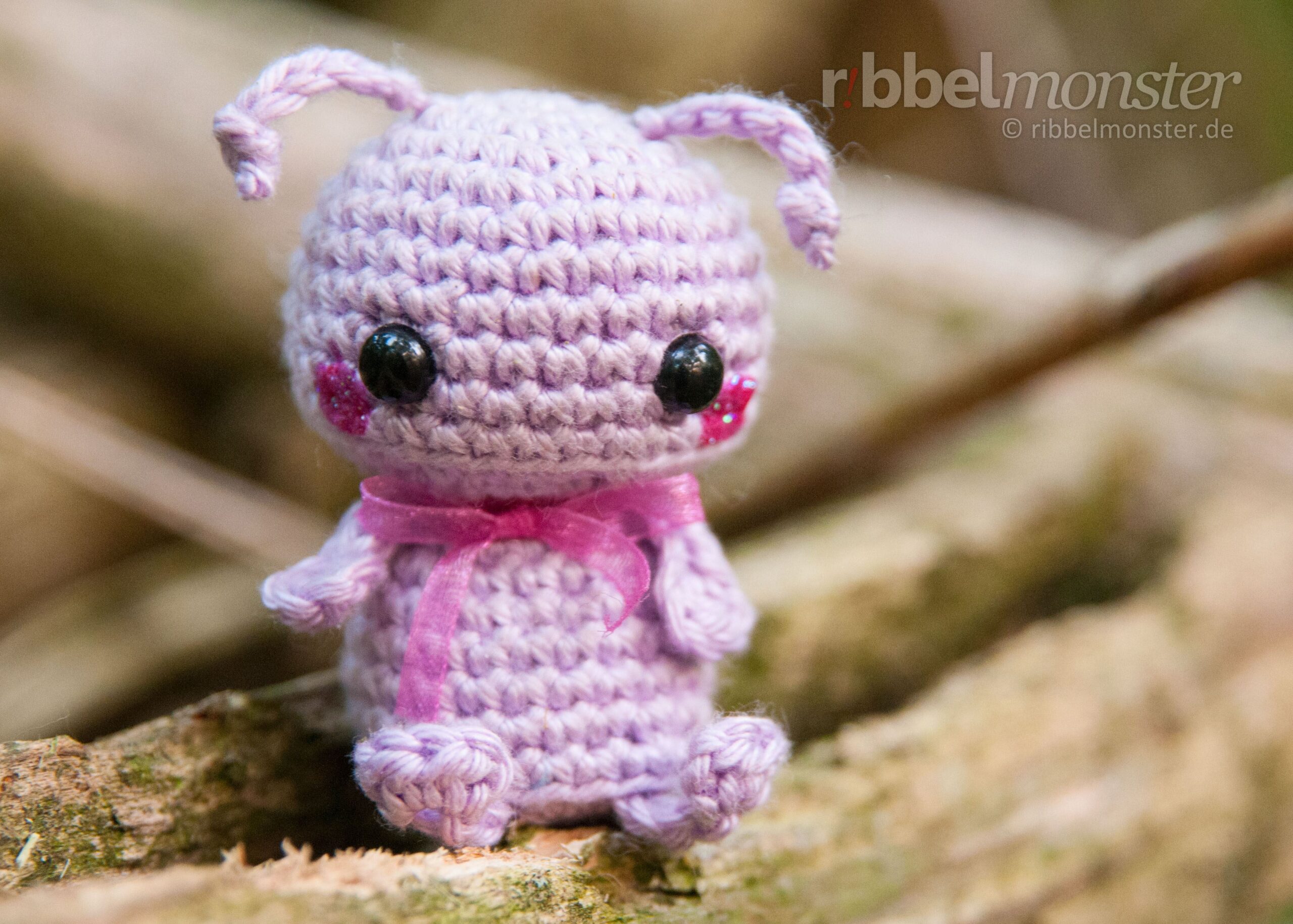Crocheting a small Bug becomes child’s play with this pattern. However, this little Bug is not only pleasing to the eye but can also be used superbly as a hanger, for a mobile, or on a keychain.





Content
Introduction: Amigurumi – Minimee Crochet Bug “Blib”
To successfully crochet the Amigurumi Bug, some preparation is essential. Therefore, you will find the necessary information about prerequisites, materials, and size here. Additionally, you can seek help through the respective additional links.
Attention! Amigurumis are very cute and, therefore, not only popular among adults. Children often see them as toys, so you should be especially careful. Amigurumis that are not intended for play should be kept out of the reach of children. If an Amigurumi is meant to be played with by children, you should strictly adhere to the guidelines for toys. If you plan to give away or sell Amigurumis (license for sellers), you must strictly adhere to the legal requirements for toys and display the required CE marking.
Prerequisites
To successfully recreate this crochet pattern for the Amigurumi Bug, it is crucial that you are already familiar with the following crochet techniques. You will find a detailed tutorial for each technique here so that you can quickly learn them yourself.
- Crochet Chain Stitches
- Crochet Magic Ring
- Crochet Slip Stitches
- Decreases
- Half Double Crochet Stitches (US!)
- Increases
- Loops of a Stitch
- Single Crochet Stitches (US!)
- spiral rounds
- Turning Chain Stitches
Note! By offsetting regular increases and decreases, they become almost invisible. You can recognize regular increases by the phrase “double every … stitch,” and regular decreases by the phrase “crochet together every … and … stitch”. The stitch chart for spheres and circles might also be helpful for you.
Note! Using a special technique for invisible decreases makes them nearly invisible. Although this technique requires a bit of practice, it’s worth giving it a try.
Supplies
The material described here was used for the shown Amigurumi Bug. You can crochet the Amigurumi Bug with any yarn and a matching hook size. You will achieve a result as identical as possible if you use materials as similar as possible. In addition to the materials, you will find all the necessary tools and supplies in the following list.
Crochet Hook
You will need a crochet hook with a size of B or C (alphabetic) or 1 1/2 (numeric). For converting to other sizes, the crochet hook size converter will help you. I have selected some great crochet hooks for you here.
Filling
For filling, I used wadding made of 100% viscose. However, there are numerous alternatives for filling material. If you’ve run out of filling, I’ve prepared a refill for you here.
Acrylic Paint
I used acrylic paint in the shade of pink here. This paint is non-toxic, water-dilutable, waterproof, and adheres to almost any surface. I found a great set of acrylic paints for you to try out here.
Pins
You’ll also need a few pins. The more colorful your collection, the better. If you need more, I’ve found something for you.
Ribbon – 1/5 inches – pink
I’ve used organza ribbon or satin ribbon here. The width is 1/5 inches. The color is pink. If you can’t find anything suitable, I’ve selected a set of beautiful ribbons for you here.
Safety Eyes
I used 2 safety eyes with a diameter of 1/4 inches. The eyes are completely black. However, there are countless alternatives for amigurumi eyes. You might prefer other safety eyes as well.
Scissors
You’ll need any scissors. It’s best to use your most beautiful scissors because it brings you joy. If you don’t have really nice scissors, I’ve picked out some lovely ones for you.
Wool Needle
You’ll need a wool needle with a blunt tip. The thickness of the wool needle should match the thickness of your yarn. You might like the set of wool needles I’ve picked out for you.
Yarn – Schachenmayr – Catania – 226 – flieder
I used yarn in the shade Lilac. The material is 100% cotton. The yardage is 137 yds / 1.75 oz. If you want to replenish your supply, I’ve already picked out the matching yarn for you here.
Note! I have used safety eyes here. If you have never attached safety eyes before, you can also find detailed instructions on how to attach safety eyes here. In addition to a wide selection of other safety eyes, there are also numerous alternatives for amigurumi eyes. Simply use the eyes that you like best.
Note! The specified yarn was used for the example shown here. In principle, you can use any yarn and an appropriate needle size. However, the quality of the material also affects the quality of the result, so you should avoid cutting corners in the wrong place. Also, the thickness of the yarn and the needle will influence the size of the outcome, which you can, of course, intentionally take advantage of.
Size
Here are the size specifications for the crocheted Amigurumi Bug. The height was measured standing without antennae. Please note that the actual size depends on the yarn used, the size of the crochet hook, and individual crochet tension.
| Needle Size | Yardage | Size |
|---|---|---|
| Crochet Hook B, C or 1 1/2 | 137 yds / 1.75 oz | 2 2/5 inch |
| Crochet Hook C, D or 2 1/2 | 120 yds / 1.75 oz | 3 inches |
| Crochet Hook E or 4 | 93 yds / 1.75 oz | ? |

Note! If you want to change the size, you can simply use a thicker or thinner yarn with a suitable needle size. Simply doubling the rounds, rows, and stitches, on the other hand, will only result in an uneven outcome.
Crochet Pattern: Amigurumi – Minimee Crochet Bug “Blib”

We crochet the small Bug in one piece from top to bottom. Afterwards, we crochet all the small parts, such as antennae, arms, and legs. Finally, everything is sewn together, and you can add a few decorations. Let’s get started!
Crochet Head for Bug (1x)

As described earlier, we crochet the head and body in one go. We start by crocheting the head from the top and work our way down in spiral rounds. Do not cut the yarn when the head is finished; instead, continue immediately with the body.
Note! If you want to achieve a particularly beautiful result, you can hide regular increases and decreases by offsetting them a little. You can recognize regular increases by the phrase “double every … stitch,” and regular decreases by the phrase “crochet together every … and … stitch”. The stitch chart for spheres and circles might also be helpful for you. Additionally, you can apply a special crochet technique here for invisible decreases.
- lavender:
- 1st round:
- magic ring
- into the magic ring:
- 6 single crochet stitches (US!)
- = 6 stitches
- 2nd round:
- double every stitch
- = 12 stitches
- 3rd round:
- double every 2nd stitch
- = 18 stitches
- 4th round:
- double every 3rd stitch
- = 24 stitches
- 5th round:
- double every 4th stitch
- = 30 stitches
- 6th – 11th round:
- (= 6 rounds)
- every stitch one stitch
- = 30 stitches
- 12th round:
- into the back loop only:
- crochet together every 4th and 5th stitch
- = 24 stitches
- into the back loop only:
- attach safety eyes, position:
- after the 9th round
- 5 stitches distance
- 13th round:
- crochet together every 3rd and 4th stitch
- = 18 stitches
- 14th round:
- crochet together every 2nd and 3rd stitch
- = 12 stitches
- fill and stuff completely
- do NOT cut yarn, continue with:
- body
Crochet Body for Bug (1x)
As described earlier, we now crochet the body directly onto the head. If you accidentally cut the yarn, you can simply continue as if starting with a new color.
Note! If you want to achieve a particularly beautiful result, you can hide regular increases and decreases by offsetting them a little. You can recognize regular increases by the phrase “double every … stitch,” and regular decreases by the phrase “crochet together every … and … stitch”. The stitch chart for spheres and circles might also be helpful for you. Additionally, you can apply a special crochet technique here for invisible decreases.
- 15th round:
- double every 4th stitch
- = 15 stitches
- 16th round:
- double every 5th stitch
- = 18 stitches
- 17th round:
- double every 6th stitch
- = 21 stitches
- 18th round:
- double every 7th stitch
- = 24 stitches
- 19th – 22nd round:
- (= 4 rounds)
- every stitch one stitch
- = 24 stitches
- 23rd round:
- into the back loop only:
- crochet together every 3rd and 4th stitch
- = 18 stitches
- into the back loop only:
- fill and stuff completely
- 24th round:
- crochet together every 2nd and 3rd stitch
- = 12 stitches
- 25th round:
- crochet together every 1st and 2nd stitch
- = 6 stitches
- cut yarn generously, pull through loop, close the remaining opening, secure and weave in the yarn end
Crochet Antennae for Bug (2x)

The antennae for your small Bug are easily crocheted in just one row. As a little crowning touch, you can also tie a few knots in the antennae.
Note! If you want to create several nearly identical parts, it’s advisable to work on them consecutively on the same day. For larger parts, it’s even recommended to work on them simultaneously in stages. Our tension and tightness can vary from day to day, leading to visible differences.
- lavender:
- 1st row:
- 10 chain stitches
- = 10 stitches
- cut yarn generously, pull through loop, do NOT cut the yarn end, it will be used later for sewing
When your antennae are finished, simply tie a knot at the beginning of the chain of stitches. The yarn end from the beginning is useful for this so that you don’t hurt your fingers. However, be careful that the knot sits on the chain of stitches and not on the yarn end. When you’re done, you can carefully cut the yarn end at the knot. But be sure not to cut into the knot or the chain of stitches, or it will literally disappear into thin air.
Crochet Arms for Bug (2x)

We crochet the arms for the Bug back and forth in two rows. Let the games begin!
Note! If you want to create several nearly identical parts, it’s advisable to work on them consecutively on the same day. For larger parts, it’s even recommended to work on them simultaneously in stages. Our tension and tightness can vary from day to day, leading to visible differences.
- lavender:
- 1st row:
- 4 chain stitches
- 2 turning chain stitches
- = 4 stitches
- 2nd row:
- into one stitch:
- 1 half double crochet stitch (US!)
- 2 turning chain stitches
- 1 slip stitch
- 3x one slip stitch into one stitch
- = 5 stitches
- into one stitch:
- cut yarn generously, pull through loop, do NOT cut the yarn end, it will be used later for sewing
Crochet Legs for Bug (2x)

Once you’ve mastered the arms, the legs are no longer a problem. Be cautious, though, as there’s a slight difference in the second row here!
Note! If you want to create several nearly identical parts, it’s advisable to work on them consecutively on the same day. For larger parts, it’s even recommended to work on them simultaneously in stages. Our tension and tightness can vary from day to day, leading to visible differences.
- lavender:
- 1st row:
- 4 chain stitches
- 2 turning chain stitches
- = 4 stitches
- 2nd row:
- into one stitch:
- 2 half double crochet stitches (US!)
- 2 turning chain stitches
- 1 slip stitch
- 3x one slip stitch into one stitch
- = 6 stitches
- into one stitch:
- cut yarn generously, pull through loop, do NOT cut the yarn end, it will be used later for sewing
Finish Minimee Bug

Before assembling the small Bug finally, you can determine the positions of the individual parts beforehand. It is very helpful to pin all the individual parts together with pins beforehand, so you can easily correct small mistakes.
Attach Arms, Legs, and Antennae

Attach the antennae to the top of the head. They are seen from the top in a line through the center of the head and parallel to the eyes. The arms are attached about 4 stitches apart after the 15th round, and the legs are attached about 3 stitches apart after the 22nd round.

It helps to first find the center based on the eyes and attach the arms and legs on each side. It is more important to maintain the same distance from the center than to maintain the exact distance between the two parts. For support, you will also find a pattern here that shows you how to attach small parts to an Amigurumi.
Create Details

Now you can give your Amigurumi Bug its own character. You can draw cheeks on it and tie a bow around its neck, but you don’t have to. There are many ways to design an Amigurumi, so let your imagination run wild!
Done!
Your little crocheted Amigurumi Bug is already finished. It would love to sleep a little in your bed. Who wouldn’t want such a cute crocheted Bug in bed, right?

If you’re up for it, you might want to crochet the other amigurumis from the Minimee series; just take a look at the patterns.

Do you feel like crocheting these two industrious friends? Here’s a pattern for the amigurumi bee Mika and a pattern for the amigurumi bumblebee Malo.

If you enjoy walking in the woods, I have a great companion for you. The amigurumi brown bear Balu is quick to crochet.

If your bed is sometimes too empty, this little crocheted amigurumi bug would love to spend a few nights there.

If you have some cheese left, the sweet amigurumi mouse Lina could enjoy it for you so that it doesn’t go bad.

A genuinely spooky pair can be found here. Why not try the patterns for the zombie girl Ouka and the zombie boy Ouk?

Also, we are urgently looking for a cool place for our charming amigurumi snowman Erik.

Our little amigurumi polar bear Ole urgently needs someone to cuddle within the cold season. Do you know someone?

With this simple crochet pattern for an amigurumi elf, you’ll surely have much less household work soon!

Snowy owls are quite rare, but we have diligently searched and found this great pattern for an amigurumi snowy owl for you.

Oh, how cute! I think a very adorable little baby snowy owl has just hatched. You definitely need to take a closer look.

If you urgently need a bit more luck, then you can simply shake hands with our amigurumi chimney sweep.

Do you have a spot in your bamboo forest? Our little amigurumi panda bear is still urgently looking for a new home.

Maybe a cute koala bear also fits into your in-house jungle? With this simple crochet guide, you can crochet the amigurumi koala bear Sina.

If you’re in the mood for some horror stories, a terrifying amigurumi Frankenstein might share his experiences with you.

